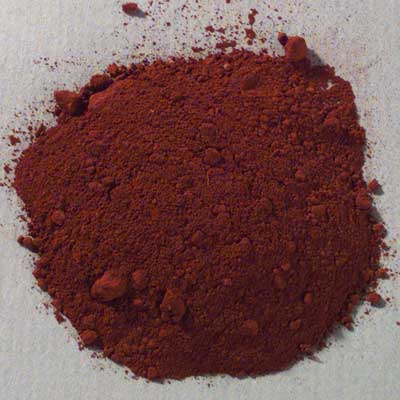Bauxite Mummy Pigment
A reddish brown pigment containing over 35% hematite. We prepare this family of pigments from sources in Russia. We could not find an equivalent in Europe or the Western Hemisphere. However, it is known among artists in Russia and eastern European countries as “mummy” because it resembles the pigment highly prized by artists of the eighteenth and nineteenth centuries. The historical pigment, which had its source in such organic matter as bitumen and asphaltum, was a fugitive color. It got its name from grisly rumors that the pigment was made by grinding Egyptian mummies. Mummy pigment that we make is not a mineral species but a natural mixture of minerals consisting of kaolin, quartz, goethite, and hematite. The latter two minerals determine the color of mummy, while the remaining ingredients are inert substances that can vary the opacity or tinting strength of the pigment. The color of mummy can vary from red to brown and finally to dark violet. The latter color is usually known as “mummy violet.” The total content of goethite and hematite usually does not exceed 60% in mummy. The more hematite in relation to goethite, the redder the mummy. A larger proportion of goethite strengthens the pigment in the yellow spectrum.
Origin and History of Use
Egyptian mummies were available by the truckload at one time. Initially reserved for the upper classes, mummification eventually became popular with the proletariat; by modern times, mummies numbered in the millions. A single burial ground discovered not long ago is thought to contain 10,000. During medieval times, they were ground into powder and used as medicine. Later in the sixteenth and seventeenth centuries, this powder was used as a paint pigment called “mummy brown” (also known as “Egyptian brown”), a practice that persisted, according to some sources, into the early 20th century. Ralph Mayer says its use was suddenly discontinued in the 19th century when the grisly composition became generally known to artists [The Artist’s Handbook, p. 52]. A London colorman informed A. H. Church that he could satisfy the demands of his customers for twenty years from one Egyptian mummy [The Chemistry of Paints and Painting, p. 236]. Ground mummies made a pigment of an undefined organic composition due to the decomposition of the mummies and the various resins that covered them. It was used primarily in watercolor and oil painting techniques. Mummy brown is a deep brown color, nearly intermediate in tint between burnt umber and raw umber. A pigment of this color was also prepared from bitumen or asphaltum. In Russia, the term “mummy” has been applied to mineral pigments that exhibit similar characteristics to this pigment. Since we derive our pigment from Russia, we have maintained the use of its name.
Source
Our mummy pigments are not organic in composition but consist entirely of natural minerals from deposits in the Kaluzhskaya province of Russia. The various mummy pigments vary from transparent to opaque, with medium to good hiding power and medium to excellent tinting strength. The largest deposits of this iron-rich mineral are found in the Bechesyn-Bermamytskoye deposit on the Stavropol border and the Shilkinskoye deposit in the Chitinskaya province of Russia.
Permanence and Compatibility
Our mummy is composed of iron oxide, calcium carbonate, kaolin, and silica, which are considered permanent and stable in mixtures with all other pigments. It is excellent in oils and all aqueous mediums, such as egg tempera, casein, and gum arabic (watercolor). It performs well in wax (encaustic) and fresco techniques.
Oil Absorption and Grinding
No data has been published on the oil absorption properties of mummy.
Toxicity
Mummy is not considered toxic, but care should be taken in handling the dry powder pigment to avoid inhaling the dust.

Rublev Colours Bauxite Mummy Pigment
| Pigment Information | |
| Color: | Brown |
| Colour Index: | Pigment Brown 7 (PBr 7) |
| ASTM Lightfastness Rating | |
| Acrylic: | Not Tested* |
| Oil: | Not Tested* |
| Watercolor: | Not Tested* |
| *Although not tested by the ASTM, this is a red iron oxide earth pigment that has excellent lightfastness in all mediums. | |
| Properties | |
| Density: | - |
| Hardness: | 2 |
| Refractive Index: | - |
Health Label
Based on a toxicological review, there are no acute or known chronic health hazards with the anticipated use of this product. Always protect yourself against potentially unknown chronic hazards of this and other chemical products by avoiding ingestion, excessive skin contact, and inhaling spraying mists, sanding dust, and concentrated vapors. Contact us for further information or consult the MSDS for more information.
| SKU | 460-22 |
|---|---|
| Brand | Rublev Colours |
| Vendor | Natural Pigments |
| Processing Time | Usually ships the next business day. |
| Color | Brown |
| Pigment Type | Inorganic, Earth, Natural |



